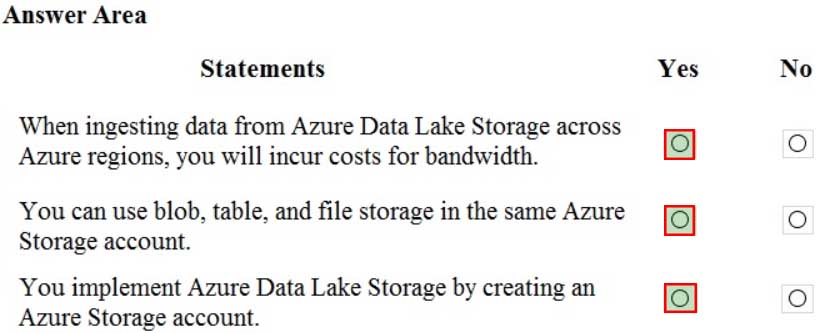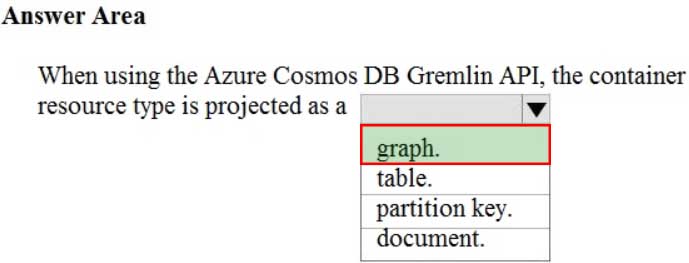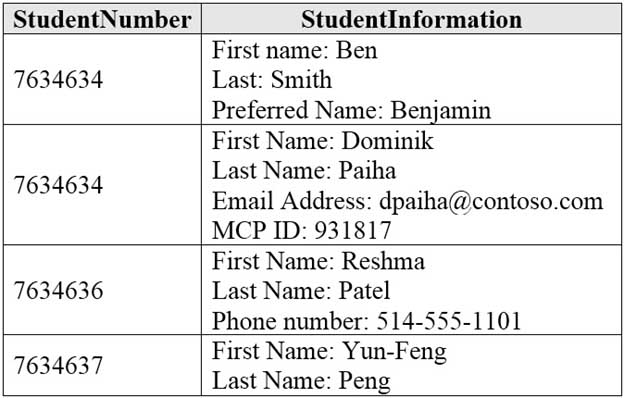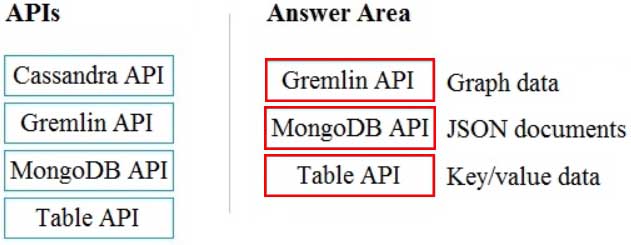DP-900 : Microsoft Azure Data Fundamentals : Part 04
-
You have an application that runs on Windows and requires access to a mapped drive.
Which Azure service should you use?
- Azure Files
- Azure Blob storage
- Azure Cosmos DB
- Azure Table storage
Explanation:
Azure Files is Microsoft’s easy-to-use cloud file system. Azure file shares can be seamlessly used in Windows and Windows Server.
To use an Azure file share with Windows, you must either mount it, which means assigning it a drive letter or mount point path, or access it via its UNC path. -
HOTSPOT
For each of the following statements, select Yes if the statement is true. Otherwise, select No.
NOTE: Each correct selection is worth one point.

DP-900 Microsoft Azure Data Fundamentals Part 04 Q02 051 Question 
DP-900 Microsoft Azure Data Fundamentals Part 04 Q02 051 Answer Explanation:Box 1: No
The API determines the type of account to create. Azure Cosmos DB provides five APIs: Core (SQL) and MongoDB for document data, Gremlin for graph data, Azure Table, and Cassandra. Currently, you must create a separate account for each API.Box 2: Yes
Azure Cosmos DB uses partitioning to scale individual containers in a database to meet the performance needs of your application. In partitioning, the items in a container are divided into distinct subsets called logical partitions. Logical partitions are formed based on the value of a partition key that is associated with each item in a container.Box 3: No
Logical partitions are formed based on the value of a partition key that is associated with each item in a container. -
Your company is designing an application that will write a high volume of JSON data and will have an application-defined schema.
Which type of data store should you use?
- columnar
- key/value
- document
- graph
Explanation:A key/value store associates each data value with a unique key.
An application can store arbitrary data as a set of values. Any schema information must be provided by the application. The key/value store simply retrieves or stores the value by key.
-
You need to recommend a non-relational data store that is optimized for storing and retrieving text files, videos, audio streams, and virtual disk images. The data store must store data, some metadata, and a unique ID for each file.
Which type of data store should you recommend?
- key/value
- columnar
- object
- document
Explanation:
Object storage is optimized for storing and retrieving large binary objects (images, files, video and audio streams, large application data objects and documents, virtual machine disk images). Large data files are also popularly used in this model, for example, delimiter file (CSV), parquet, and ORC. Object stores can manage extremely large amounts of unstructured data. -
Your company is designing a data store for internet-connected temperature sensors.
The collected data will be used to analyze temperature trends.
Which type of data store should you use?
- relational
- time series
- graph
- columnar
Explanation:
Time series data is a set of values organized by time. Time series databases typically collect large amounts of data in real time from a large number of sources. Updates are rare, and deletes are often done as bulk operations. Although the records written to a time-series database are generally small, there are often a large number of records, and total data size can grow rapidly. -
HOTSPOT
For each of the following statements, select Yes if the statement is true. Otherwise, select No.
NOTE: Each correct selection is worth one point.

DP-900 Microsoft Azure Data Fundamentals Part 04 Q06 052 Question 
DP-900 Microsoft Azure Data Fundamentals Part 04 Q06 052 Answer -
HOTSPOT
To complete the sentence, select the appropriate option in the answer area.

DP-900 Microsoft Azure Data Fundamentals Part 04 Q07 053 Question 
DP-900 Microsoft Azure Data Fundamentals Part 04 Q07 053 Answer -
At which two levels can you set the throughput for an Azure Cosmos DB account? Each correct answer presents a complete solution. (Choose two.)
NOTE: Each correct selection is worth one point.
- database
- item
- container
- partition
-
HOTSPOT
For each of the following statements, select Yes if the statement is true. Otherwise, select No.
NOTE: Each correct selection is worth one point.

DP-900 Microsoft Azure Data Fundamentals Part 04 Q09 054 Question 
DP-900 Microsoft Azure Data Fundamentals Part 04 Q09 054 Answer -
DRAG DROP
Match the types of data stores to the appropriate scenarios.
To answer, drag the appropriate data store type from the column on the left to its scenario on the right. Each data store type may be used once, more than once, or not at all.
NOTE: Each correct match is worth one point.

DP-900 Microsoft Azure Data Fundamentals Part 04 Q10 055 Question 
DP-900 Microsoft Azure Data Fundamentals Part 04 Q10 055 Answer -
You have an Azure Cosmos DB account that uses the Core (SQL) API.
Which two settings can you configure at the container level? Each correct answer presents a complete solution. (Choose two.)
NOTE: Each correct selection is worth one point.
- the throughput
- the read region
- the partition key
- the API
-
Your company is designing a data store that will contain student data. The data has the following format.

DP-900 Microsoft Azure Data Fundamentals Part 04 Q12 056 Which type of data store should you use?
- graph
- key/value
- object
- columnar
-
Which storage solution supports role-based access control (RBAC) at the file and folder level?
- Azure Disk Storage
- Azure Data Lake Storage
- Azure Blob storage
- Azure Queue storage
-
You need to store data in Azure Blob storage for seven years to meet your company’s compliance requirements. The retrieval time of the data is unimportant. The solution must minimize storage costs.
Which storage tier should you use?
- Archive
- Hot
- Cool
-
Which type of non-relational data store supports a flexible schema, stores data as JSON files, and stores the all the data for an entity in the same document?
- document
- columnar
- graph
- time series
-
DRAG DROP
Match the Azure Cosmos DB APIs to the appropriate data structures.
To answer, drag the appropriate API from the column on the left to its data structure on the right. Each API may be used once, more than once, or not at all.
NOTE: Each correct match is worth one point.

DP-900 Microsoft Azure Data Fundamentals Part 04 Q16 057 Question 
DP-900 Microsoft Azure Data Fundamentals Part 04 Q16 057 Answer -
HOTSPOT
To complete the sentence, select the appropriate option in the answer area.

DP-900 Microsoft Azure Data Fundamentals Part 04 Q17 058 Question 
DP-900 Microsoft Azure Data Fundamentals Part 04 Q17 058 Answer -
HOTSPOT
To complete the sentence, select the appropriate option in the answer area.

DP-900 Microsoft Azure Data Fundamentals Part 04 Q18 059 Question 
DP-900 Microsoft Azure Data Fundamentals Part 04 Q18 059 Answer -
When provisioning an Azure Cosmos DB account, which feature provides redundancy within an Azure region?
- multi-master replication
- Availability Zones
- the strong consistency level
- automatic failover
Explanation:With Availability Zone (AZ) support, Azure Cosmos DB will ensure replicas are placed across multiple zones within a given region to provide high availability and resiliency to zonal failures.
Note: Azure Cosmos DB provides high availability in two primary ways. First, Azure Cosmos DB replicates data across regions configured within a Cosmos account. Second, Azure Cosmos DB maintains 4 replicas of data within a region.
-
What is a benefit of the Azure Cosmos DB Table API as compared to Azure Table storage?
- provides resiliency if an Azure region fails
- supports partitioning
- provides a higher storage capacity
- supports a multi-master model
Explanation:
Multi-master support for Azure Cosmos DB is now available in all public regions.
Azure CosmosDB table API is a key-value storage hosted in the cloud. It’s a part of Azure Cosmos DB, that is Microsoft’s multi-model database.